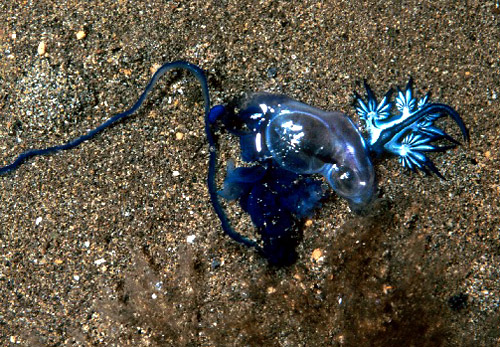Glaucus atlanticus
 These sea slugs are pelagic: they float upside down by using the surface tension of the water to stay up, where they are carried along by the winds and ocean currents. Glaucus atlanticus is camouflaged: the blue side of their body faces upwards, blending in with the blue of the water. The silver/grey side of the sea slugs faces downwards, blending in with the silvery surface of the sea.
These sea slugs are pelagic: they float upside down by using the surface tension of the water to stay up, where they are carried along by the winds and ocean currents. Glaucus atlanticus is camouflaged: the blue side of their body faces upwards, blending in with the blue of the water. The silver/grey side of the sea slugs faces downwards, blending in with the silvery surface of the sea.
Glaucus atlanticus feeds on other pelagic creatures, including the venomoussiphonophore, the Portuguese man o' war. This sea slug stores stinging nematocystsfrom the cnidarian within its own tissues as defense against predation. Humans handling the slug may receive a very painful and potentially dangerous sting.
This nudibranch is pelagic, and there is some evidence that it occurs throughout the world's oceans, in temperate and tropical waters. It has been recorded from the east and south coasts of South Africa, European waters, the east coast of Australia, and Mozambique
Glaucus atlanticus was recently found in the Humboldt Current ecosystem in Peru in 2013, and off Andhra Pradesh in India in 2012. This is in line with the known habitat characteristics of the species: they live in warm temperate climates in the Southern Pacific, and in circumtropical and Lusitanian environments. Before finding Glaucus atlanticus off Andhra Pradesh, these nudibranchs were documented as having been seen in the Bay of Bengal and off the coast of Tamil Nadu, India, over 677 kilometers apart.[8] Glaucus atlanticus was also recently found off Bermuda in January 2016.[9]
Although these sea slugs live on the open ocean, they sometimes accidentally wash up onto the shore, and therefore they may be found on beaches.[10]
A rare sea slug called a 'Blue Dragon' (Glaucus atlanticus) washed up on the shores of Queensland in Australia. This magnificent beauty, mostly found in tropical waters, looks like a creature straight from the Pokémon game but don't let its good looks fool you.
Blue Dragons float upside down on the surface of tropical waters and target blue bottle jellyfish. They ingest the poisonous cells of the jellyfish, which they then use on their own predators.
When fully grown, the shell-less Blue Dragon sea slug measures an inch long. It also has amazing camouflage abilities. Its beautiful blue underside enables it to blend with the water's surface as it floats upside down. Underwater, its other silvery side aids in its survival.
Much like its prey, the Blue Dragon can cause very painful stings to humans. Upon spotting a Blue Dragon on the shore, people are advised not to touch it, despite the mesmerizing allure. The Blue Dragon's beauty is best admired from a safe distance, just like these other 'cute' animals that pack a deadly punch.
Amazing green Sea Sheep (Costasiella Kuroshimae)
Pretty pink Phyllodesmium Poindimiei
READ MORE >>>8colors
even in a simple picture
learn how.....
8colors
is a non-profit organization
help us to create more .....
if you want to donate it is good for
us to survived












Comments
Post a Comment